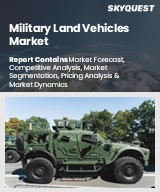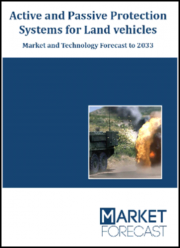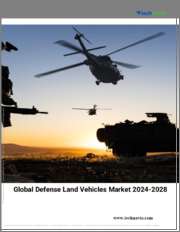
|
시장보고서
상품코드
1758611
군용 육상 차량 시장 : 시장 규모, 점유율, 성장 분석 - 제공 내용별, 유형별, 이동 수단별, 용도별, 지역별 산업 예측(2025-2032년)Military Land Vehicles Market Size, Share, and Growth Analysis, By Offerings (Platforms, Services), By Type (Light protected vehicles, Armored personnel carriers), By Mobility Capability, By Applications, By Region - Industry Forecast 2025-2032 |
||||||
세계의 군용 육상 차량 시장 규모는 2023년에 248억 달러로 평가되었고, 예측 기간인 2025-2032년 CAGR 4.1%로 성장할 전망이며, 2024년 258억 2,000만 달러에서 2032년에는 356억 달러로 성장할 전망입니다.
세계의 군용 육상 차량 시장은 광범위한 근대화 노력으로 큰 변혁기를 맞이하고 있습니다. 각국은 전장에서의 유효성을 향상시키기 위해 시대에 뒤떨어진 전차, 보병전투차량(IFV), 장갑병 수송차(APC)를 선진적인 네트워크화된 모델로 대체하는 것을 우선시하고 있습니다. 특히 미국과 같은 강대국에 의한 국방 지출의 증가는 장갑 함대의 업그레이드 수요를 부추기고 있습니다. 자율 시스템, 전기 추진, AI 센서 등의 최첨단 기술은 군사 능력을 재구축하고 성능, 상황 인식, 운용 효율을 향상시키며 진화하는 방위 요구에 부응하고 있습니다. 계속되는 지역적 긴장 및 지정학적 불안정성으로 군사 조직은 지상 부대에 대한 투자를 강화할 수밖에 없어 시장의 기세는 지속되고 있습니다. 예산 삭감이나 기술 배치의 지연이라고 하는 과제에도 불구하고, 차세대 차량에 대한 주력은, 전략적 제휴나 우선 지역에 있어서의 현지 생산의 영향을 받아, 장기적인 성장을 지지하고 있습니다.
목차
서문
- 분석 목적
- 시장 범위
- 정의
분석 기법
- 정보 조달
- 2차 및 1차 데이터의 수법
- 시장 규모 예측
- 시장의 상정 및 제약
주요 요약
- 시장 개요 및 전망
- 수급 동향의 분석
- 부문별 기회 분석
시장 역학 및 전망
- 시장 개요
- 시장 규모
- 시장 역학
- 성장 촉진요인 및 기회
- 성장 억제요인 및 과제
- Porter's Five Forces 분석
주요 시장 인사이트
- 주요 성공 요인
- 경쟁도
- 주요 투자 기회
- 시장 생태계
- 시장 매력도 지수(2024년)
- PESTEL 분석
- 거시경제지표
- 밸류체인 분석
- 사례 연구
세계의 군용 육상 차량 시장 규모 및 CAGR : 제공 내용별(2025-2032년)
- 시장 개요
- 플랫폼
- 서비스
세계의 군용 육상 차량 시장 규모 및 CAGR : 유형별(2025-2032년)
- 시장 개요
- 소형 장갑차
- 장갑병원 수송차
- 보병 전투 차량
- 주력 탱크
- 기타
세계의 군용 육상 차량 시장 규모 및 CAGR : 이동 수단별(2025-2032년)
- 시장 개요
- 궤도식
- 바퀴식
- 수륙 양용
세계의 군용 육상 차량 시장 규모 및 CAGR : 용도별(2025-2032년)
- 시장 개요
- 방위
- 수송
세계의 군용 육상 차량 시장 규모 및 CAGR(2025-2032년)
- 북미
- 미국
- 캐나다
- 유럽
- 독일
- 스페인
- 프랑스
- 영국
- 이탈리아
- 기타 유럽
- 아시아태평양
- 중국
- 인도
- 일본
- 한국
- 기타 아시아태평양
- 라틴아메리카
- 브라질
- 기타 라틴아메리카
- 중동 및 아프리카
- GCC 국가
- 남아프리카
- 기타 중동 및 아프리카
경쟁 구도
- 상위 5개사 비교
- 주요 기업의 시장 포지셔닝(2024년)
- 주요 기업이 채용한 전략
- 시장의 최근 동향
- 주요 기업의 시장 점유율(2024년)
- 주요 기업 프로파일
- 기업 개요
- 제품 포트폴리오 분석
- 부문별 점유율 분석
- 수익의 전년대비 비교(2022-2024년)
주요 기업 프로파일
- General Dynamics Corporation
- BAE Systems plc
- Rheinmetall AG
- Oshkosh Corporation
- Lockheed Martin Corporation
- Thales Group
- Textron Inc.
- KMW Nexter Defense Systems
- ST Engineering Ltd.
- Iveco Defense Vehicles
- Ashok Leyland Ltd.
- Leonardo SpA
- Hanwha Defense
- Tata Motors Limited
- Krauss-Maffei Wegmann GmbH & Co. KG
- Rostec State Corporation
- Hyundai Rotem Company
- China North Industries Group Corporation Limited(NORINCO)
결론 및 권고
AJY 25.07.04Global Military Land Vehicles Market size was valued at USD 24.8 billion in 2023 and is poised to grow from USD 25.82 billion in 2024 to USD 35.6 billion by 2032, growing at a CAGR of 4.1% during the forecast period (2025-2032).
The global military land vehicles market is undergoing a significant transformation driven by extensive modernization efforts. Nations are prioritizing the replacement of outdated tanks, infantry fighting vehicles (IFVs), and armored personnel carriers (APCs) with advanced, networked models to improve battlefield effectiveness. Increased defense spending, particularly by major powers like the United States, is fueling demand for upgraded armored fleets. Cutting-edge technologies, including autonomous systems, electric propulsion, and AI sensors, are reshaping military capabilities, enhancing performance, situational awareness, and operational efficiency to meet evolving defense needs. Ongoing regional tensions and geopolitical instability compel military organizations to bolster ground force investments, sustaining market momentum. Despite challenges such as budget cuts and technological deployment delays, the focus on next-generation vehicles supports long-term growth, influenced by strategic alliances and local production in priority regions.
Top-down and bottom-up approaches were used to estimate and validate the size of the Global Military Land Vehicles market and to estimate the size of various other dependent submarkets. The research methodology used to estimate the market size includes the following details: The key players in the market were identified through secondary research, and their market shares in the respective regions were determined through primary and secondary research. This entire procedure includes the study of the annual and financial reports of the top market players and extensive interviews for key insights from industry leaders such as CEOs, VPs, directors, and marketing executives. All percentage shares split, and breakdowns were determined using secondary sources and verified through Primary sources. All possible parameters that affect the markets covered in this research study have been accounted for, viewed in extensive detail, verified through primary research, and analyzed to get the final quantitative and qualitative data.
Global Military Land Vehicles Market Segments Analysis
Global Military Land Vehicles Market is segmented by Offerings, Type, Mobility Capability, Applications and region. Based on Offerings, the market is segmented into Platforms and Services. Based on Type, the market is segmented into Light protected vehicles, Armored personnel carriers, Infantry fighting vehicles, Main battle tanks and Others. Based on Mobility Capability, the market is segmented into Tracked, Wheeled and Amphibious. Based on Applications, the market is segmented into Defense and Transportation. Based on region, the market is segmented into North America, Europe, Asia Pacific, Latin America and Middle East & Africa.
Driver of the Global Military Land Vehicles Market
The expansion of the global military land vehicles market is primarily driven by increasing defense spending worldwide. Nations are prioritizing the procurement of advanced armored vehicles, including tanks, infantry fighting vehicles, and personnel carriers, along with the modernization of existing fleets. Key programs implemented in various regions aim to enhance operational capabilities, stimulate innovation, and sustain market demand. As military organizations invest in state-of-the-art platforms to adapt to evolving defense needs, they strive to secure a strategic edge over potential adversaries. This ongoing investment underscores the critical role of military land vehicles in national security strategies globally.
Restraints in the Global Military Land Vehicles Market
The global military land vehicles market faces significant challenges due to the high costs associated with the design, testing, and maintenance of sophisticated military vehicles. The integration of advanced armor, cutting-edge electronics, and autonomous systems considerably elevates expenses, which may lead to delays in procurement or limit program sizes, especially for nations with tight budgets. These financial constraints hinder market expansion, as the elevated costs restrict access to advanced military platforms, resulting in lower adoption rates in resource-limited regions. Consequently, the high costs of these vehicles represent a considerable restraint on the growth of the global military land vehicles market.
Market Trends of the Global Military Land Vehicles Market
The Global Military Land Vehicles market is experiencing a significant trend towards augmented autonomy and advanced robotics, reflecting a growing emphasis on unmanned ground vehicles and artificial intelligence integration. Modern military forces are increasingly incorporating robotic combat vehicles and sophisticated driver-assist/autopilot technologies, aimed at enhancing operational mobility while minimizing crew risks during missions. This shift is exemplified by the deployment of unmanned heavy trucks and autonomous logistics convoys, which streamline resupply operations and highlight the strategic transition towards networked and automated warfare, ultimately reshaping the landscape of military capabilities and operational effectiveness in the 21st century.
Table of Contents
Introduction
- Objectives of the Study
- Scope of the Report
- Definitions
Research Methodology
- Information Procurement
- Secondary & Primary Data Methods
- Market Size Estimation
- Market Assumptions & Limitations
Executive Summary
- Global Market Outlook
- Supply & Demand Trend Analysis
- Segmental Opportunity Analysis
Market Dynamics & Outlook
- Market Overview
- Market Size
- Market Dynamics
- Drivers & Opportunities
- Restraints & Challenges
- Porters Analysis
- Competitive rivalry
- Threat of substitute
- Bargaining power of buyers
- Threat of new entrants
- Bargaining power of suppliers
Key Market Insights
- Key Success Factors
- Degree of Competition
- Top Investment Pockets
- Market Ecosystem
- Market Attractiveness Index, 2024
- PESTEL Analysis
- Macro-Economic Indicators
- Value Chain Analysis
- Pricing Analysis
- Case Studies
Global Military Land Vehicles Market Size by Offerings & CAGR (2025-2032)
- Market Overview
- Platforms
- Services
Global Military Land Vehicles Market Size by Type & CAGR (2025-2032)
- Market Overview
- Light protected vehicles
- Armored personnel carriers
- Infantry fighting vehicles
- Main battle tanks
- Others
Global Military Land Vehicles Market Size by Mobility Capability & CAGR (2025-2032)
- Market Overview
- Tracked
- Wheeled
- Amphibious
Global Military Land Vehicles Market Size by Applications & CAGR (2025-2032)
- Market Overview
- Defense
- Transportation
Global Military Land Vehicles Market Size & CAGR (2025-2032)
- North America (Offerings, Type, Mobility Capability, Applications)
- US
- Canada
- Europe (Offerings, Type, Mobility Capability, Applications)
- Germany
- Spain
- France
- UK
- Italy
- Rest of Europe
- Asia Pacific (Offerings, Type, Mobility Capability, Applications)
- China
- India
- Japan
- South Korea
- Rest of Asia-Pacific
- Latin America (Offerings, Type, Mobility Capability, Applications)
- Brazil
- Rest of Latin America
- Middle East & Africa (Offerings, Type, Mobility Capability, Applications)
- GCC Countries
- South Africa
- Rest of Middle East & Africa
Competitive Intelligence
- Top 5 Player Comparison
- Market Positioning of Key Players, 2024
- Strategies Adopted by Key Market Players
- Recent Developments in the Market
- Company Market Share Analysis, 2024
- Company Profiles of All Key Players
- Company Details
- Product Portfolio Analysis
- Company's Segmental Share Analysis
- Revenue Y-O-Y Comparison (2022-2024)
Key Company Profiles
- General Dynamics Corporation
- Company Overview
- Business Segment Overview
- Financial Updates
- Key Developments
- BAE Systems plc
- Company Overview
- Business Segment Overview
- Financial Updates
- Key Developments
- Rheinmetall AG
- Company Overview
- Business Segment Overview
- Financial Updates
- Key Developments
- Oshkosh Corporation
- Company Overview
- Business Segment Overview
- Financial Updates
- Key Developments
- Lockheed Martin Corporation
- Company Overview
- Business Segment Overview
- Financial Updates
- Key Developments
- Thales Group
- Company Overview
- Business Segment Overview
- Financial Updates
- Key Developments
- Textron Inc.
- Company Overview
- Business Segment Overview
- Financial Updates
- Key Developments
- KMW + Nexter Defense Systems
- Company Overview
- Business Segment Overview
- Financial Updates
- Key Developments
- ST Engineering Ltd.
- Company Overview
- Business Segment Overview
- Financial Updates
- Key Developments
- Iveco Defense Vehicles
- Company Overview
- Business Segment Overview
- Financial Updates
- Key Developments
- Ashok Leyland Ltd.
- Company Overview
- Business Segment Overview
- Financial Updates
- Key Developments
- Leonardo S.p.A.
- Company Overview
- Business Segment Overview
- Financial Updates
- Key Developments
- Hanwha Defense
- Company Overview
- Business Segment Overview
- Financial Updates
- Key Developments
- Tata Motors Limited
- Company Overview
- Business Segment Overview
- Financial Updates
- Key Developments
- Krauss-Maffei Wegmann GmbH & Co. KG
- Company Overview
- Business Segment Overview
- Financial Updates
- Key Developments
- Rostec State Corporation
- Company Overview
- Business Segment Overview
- Financial Updates
- Key Developments
- Hyundai Rotem Company
- Company Overview
- Business Segment Overview
- Financial Updates
- Key Developments
- China North Industries Group Corporation Limited (NORINCO)
- Company Overview
- Business Segment Overview
- Financial Updates
- Key Developments



















